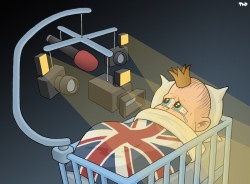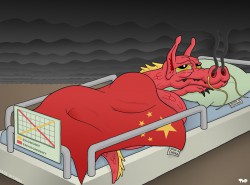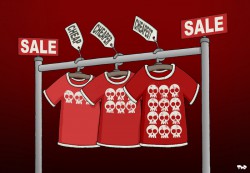There is More Than One Truth: Tjeerd Royaards and Cartoon Movement
by Olivia Stransky / August 8, 2013 / 1 Comment
In 2008, Dutch journalists Thomas Loudon and Arend Jan van den Beld founded VJ Movement, a website dedicated to creating a network of video journalists who could share their work and explore different perspectives in media coverage. Soon after it was founded, Tjeerd Royaards, an editorial cartoonist, was brought on board. It didn’t take long for Royaards to realize that cartoonists also needed an international network and platform to share their work. In 2010, he and the founders of VJ Movement launched a second website: Cartoon Movement.
The website has a two-tiered mission. The first is to create an international network that includes cartoonists from every country in the world. The second mission, inspired by Tjeerd’s own work as a freelance cartoonist, is to create a sustainable future for editorial cartoons on the internet. That’s why Cartoon Movement pays for every cartoon it publishes, while also providing clients for the cartoonists.
Sampsonia Way spoke to Tjeerd Royaards in July 2013 about the founding of Cartoon Movement, the advantages of “comics journalism,” and the personal conflicts of uncensored speech.
So before you were involved with Cartoon Movement, you were an editorial cartoonist in your own right. Was there a specific event or person or cartoon that really inspired you to get involved in Cartoon movement?
No, actually, it was a bit of coincidence getting involved with Cartoon Movement. I worked on the sidelines for VJ Movement, helping the founders out,, and then one day over lunch we got talking about how there wasn’t a network like VJ Movement for editorial cartoonists. After that VJ Movement began featuring both cartoonists and video journalists. The cartoonist network grew so quickly and was so successful that in 2010 we decided to create a separate website called Cartoon Movement and to create a platform that’s specifically focused on editorial cartoons and cartoonists.
We were very lucky, unfortunately cartoonists are “lucky” when things go wrong in the world. We launched in December 2010, and in January 2011 the Arab Spring broke. One of our cartoonists, Sherif Arafa, was an Egyptian living in the United Arab Emirates. When there was an internet blackout in Egypt, he was one of the few cartoonists able to draw about Egypt from an insider’s perspective and share them outside of the country.
You have a section on your website called “Comics Journalism.” What kind of advantages does that has to offer as compared to traditional journalism?
I often compare comics journalism to in-depth reporting. It’s not great for fast news because the average production time is about three months, so it’s best for telling a longer story and providing background and perspective. It works very well when you’re covering a sensitive issue and your sources don’t want to be recognized. For an article you would use anonymity, and for a video you would blur faces, but the cool thing with comics journalism is that you can draw them in quite a different way–make them anonymous but still do justice to the story.
We did a collaboration with cartoonist Matt Bors about homophobia in Haiti, which is a really sensitive issue. We made a video, and instead of blurring the faces of interviewees, we used aspects of comics journalism.
Another value comics journalism has is that the equipment that you need is far less intrusive than for photography or video. We did a report about the arts program inside Folsom Prison, and you’re not allowed to bring cameras in there, but you are allowed to bring a pencil and notepad, so we made a graphic novel. Again, that provides added value, on top of any written report where you wouldn’t have any kind of visuals.
We also do a lot of comics journalism that’s interactive where we incorporate audio, video, and links within the comic.
There’s another section on your website–Newsroom. How does it work in comparison with a traditional newsroom?
The Newsroom is the heart of our website–the same way the newsroom is the heart of the newspaper. All our cartoonists submit their work to the Newsroom. On an average day we get sixty to one hundred cartoons coming in, and every day we select one cartoon for our homepage. It’s based on the number of votes as well as current events, what fits, and what sells best to other media because we also have to make money, unfortunately.
Another thing we do in the Newsroom is create subrooms about different topics for other media or organizations. At the moment, we have one on the protests in Turkey. Recently we did a pitch on old age and the consequences of old age for a magazine. We set up a subroom on a specific theme or subject–whatever a client wants–and we ask our network of cartoonists to submit cartoons on that particular subject. It’ll run for anywhere between a week and a month, and at the end of that period the client chooses the cartoons they like best.
What kinds of clients and organizations do you work with?
It’s quite a variety. There’s the media aspect of the site: We work with a bunch of magazines and newspapers from around the world who buy cartoons through us.
We also do work with NGOs where our cartoonists will create a series of illustrations on a particular subject. The most recent one was for a fair labor organization about problems in the clothing manufacturing industry in response to the sweatshop collapse in Bangladesh. In the past we’ve also done projects with Twitter where we ask people to Tweet about certain topics, and our cartoonists use those tweets as inspiration for cartoons. The “reward” for our audience is a cartoon based on their tweet.
We try to be as diverse as possible, and it’s part of our mission to look outside of the scope of media, where editorial cartoons can be relevant, where they can add value.
Is that the kind of relationship you guys have with Cartoonist Rights Network International?
It’s a little bit different. We work with CRNI because we think it’s a really important organization, so our organizations help each other wherever we can. We feel that they’re doing great work, and we share their mission of being dedicated to freedom of speech and supporting cartoonists who are in trouble because of their work.
Is there a specific area where the majority of your contributors come from?
We have about ten cartoonists from Egypt, which comes in handy since the country’s been in turmoil ever since we began. There are between ten and twenty from Italy. I just hired the 13th cartoonist from Cuba. We just recently had two cartoonists from Burma join us: Kyaw Thu Yein and Lai Lone. Our first cartoonist from Somalia will be joining us this week, which is also pretty cool. I have hope that within a couple of years we’ll have almost every country on the map; I’m still looking for an editorial cartoonist from North Korea, but that’s a hard one.
Have you had to deal with any issues in making your website available or accessible to cartoonists and viewers in countries that limit the internet? (like Iran, China, N. Korea?)
Well, we’ve been censored in China for almost six months, ever since we published a comic about Nepal. We try to track where we’re censored, and in our short history, it’s only been China. Also North Korea, but I don’t know which website isn’t blocked in North Korea.
So have you personally, or the organization as a whole, received threats because of any cartoons you published?
Not yet. We’ve had some controversial cartoons, but the discussions that we’ve had on the platform have been really open and nonthreatening. We try to publish everything. Obviously, not everything is tasteful or something we agree with, but we’d rather have it generate discussion than censor it. And up until now that’s actually worked quite well, so we’re very lucky that we haven’t received any threats yet.
There have been heated discussions. There was one cartoon we received from a Russian cartoonist that was really close to my saying, “Okay, I’m just going to ban this,” but I didn’t, in the end. It’s regarding gay marriage. I totally disagree with the cartoon; I think it’s pretty tasteless and offensive, but I do like the fact that we have a discussion going on underneath it.
These are really difficult issues. We also have this kind of issue when there are Middle Eastern cartoonists drawing about Israel, because they sometimes use symbology that Europeans are far more sensitive to or consider anti-Semitic. But, as I said, I’d rather have it generate a meaningful discussion than censor it. And I’m not saying I won’t ever censor anything on Cartoon Movement, but I’d like not to. This is the other side of the coin of editorial cartooning, especially when you’re hosting a platform dedicated to free speech and that’s dedicated to saying “Hey, Cartoonists, you can post whatever you want here.” So this Russian cartoon was–for me–the first real test of our commitment to free speech.
So if cartoonists who work for you, or who are published on the site, are jailed or threatened, are there any resources that Cartoon Movement has access to help them?
Well, we have an extensive network. About five months ago one of our Palestinian cartoonists was arrested by the Israeli Defense Force, and we worked closely with Cartoonists’ Rights Network International, Reporters Without Borders, and Committee to Protect Journalists. All together we tried to offer legal aid and aid for the family. We’re really well connected with other organizations in order to immediately provide legal assistance. And our job as Cartoon Movement is to make known to the world that this is happening, so we had a live blog which tracked everything that was happening.
In your opinion, which five countries are the most dangerous to be in as a cartoonist right now?
I’d say North Korea, but there are no editorial cartoonists in North Korea. I think Iran is still very dangerous. Underrated, but Mexico is definitely also not a good place to be a journalist. I think Egypt deserves to be on that list, because I’m hearing from Egyptian cartoonists that it’s even worse than it was under Mubarak. At least under Mubarak you knew what the taboos were, you knew where to draw the line, but now you have no idea. It’s more of a mob mentality, which is far more dangerous. China and Zimbabwe, as well. I think there’s a lot more than five. It’s tough, but I could easily come up with 20 countries I think.
What’s the most common theme that you’re seeing addressed by cartoonists?
Human rights, in general, and freedom of speech, in particular. Freedom of speech is obviously a big theme because it’s at the heart of editorial cartooning. The core of editorial cartoons is to attack power, and so naturally, you get into the area of human rights, because the abuse of power often takes the form of human rights violations.
Where did the motto of your website, “There’s more than one truth,” come from?
That’s something that Thomas, one of the founders of VJ Movement, came up with. He was stationed as a reporter in Iran, and every night all the reporters that were stationed there would meet in a bar to talk about what they did that day. All these journalists from around the world would shoot or write about the same story. What Thomas found out was that even though everyone covered the same subject, they all did it differently. He realized that even though they’re trying to make what’s called “objective journalism,” they’re still bringing this heap of baggage with them, because of who they are and because your perspective of the world is shaped by your experiences. That led him to create a website for video journalism of all different perspectives from different parts of the world, with the tagline “There’s more than one truth.” Obviously, that applies to editorial cartoons as well.
What’s next? What’s something you want the organization to do that you haven’t been able to do yet?
As I said, comics journalism is really, really great for providing background. What annoys the hell out of me in international media is that there is a five minute attention span for everything that’s going on. Right now Egypt’s in the spotlight, and Syria’s been forgotten. Next week, Egypt will be forgotten and something else will take precedence.
There is a project that we’re working on which is similar to a project we did two years ago, in Haiti. We had the nation’s journalists tell the story of Haiti two years after the earthquake and had that story illustrated by the nation’s artists. We’d love to do the same project in Libya. You don’t hear anything anymore about Libya. Where is the country going after the Arab Spring? We’d love to go there and find good Libyan journalists and comic artists. It’s been very difficult to find funding for it, and it’s possible we might crowdfund it. So that’s one big thing that’s in the pipeline.
We’re currently working with the London School of Economics on an app which will be an interactive piece of comics journalism about the International Criminal Court (ICC). We currently already have an interactive comic about the ICC, but we’re going to add to it by incorporating student research projects.









One Comment on "There is More Than One Truth: Tjeerd Royaards and Cartoon Movement"
Trackbacks for this post